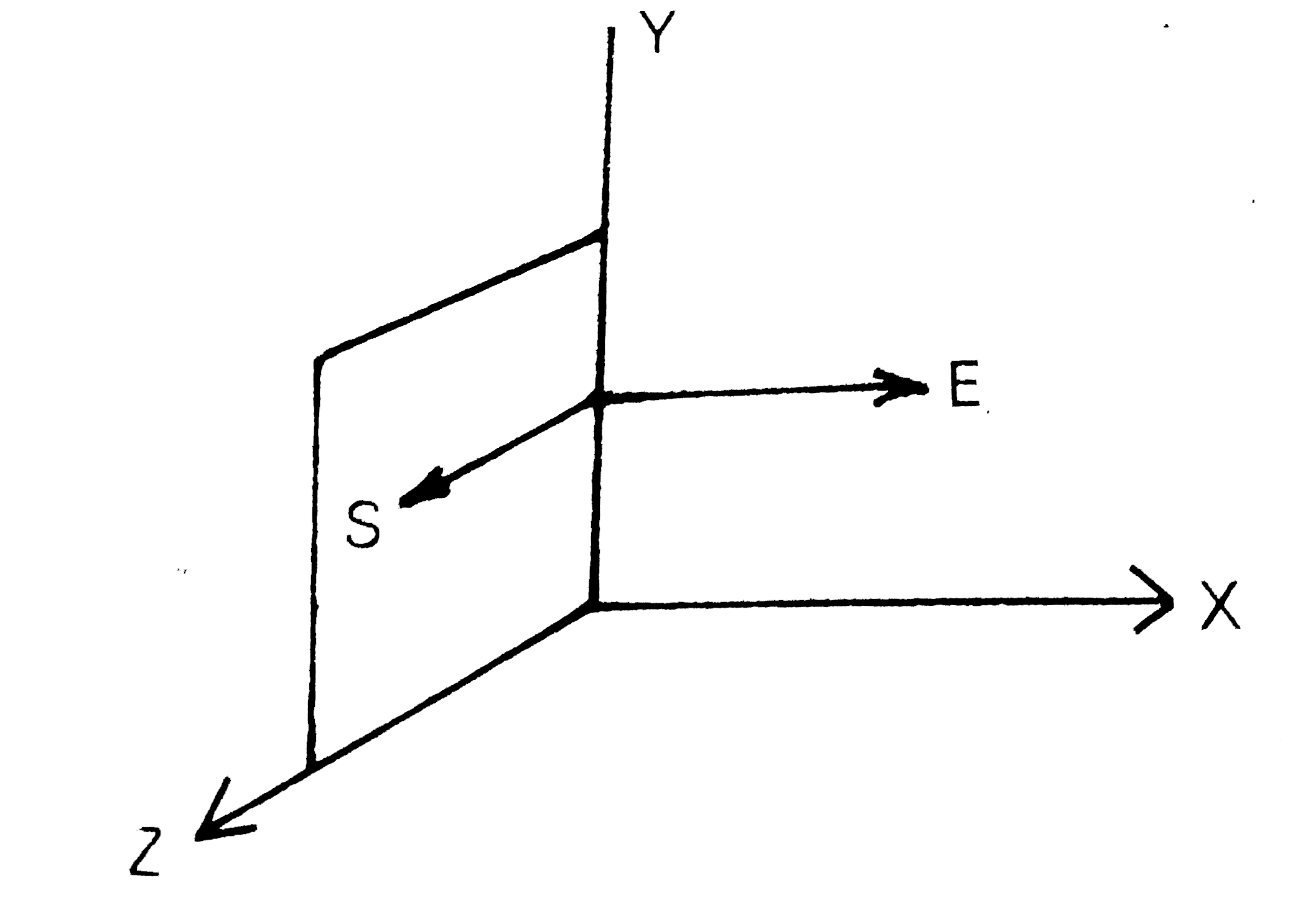Consider a uniform electric field ¯¯¯E=3×103NC−1. What is the flux of this field through a square of 10 cm on a side whose plane is parallel to the YZ plane?Solution in Telugu
Given →E=3×103ˆiN/C
As the surface is in Y - Z plane, so the area vector (normal to the square) is along X -axis.
Area S=10×10=100cm2=10−2m2.
Area vector →S=10−2ˆim2
ϕ=→E.→S=(3×103ˆi).(10−2ˆi)
∴ϕ=3×103×10−2=30N−m2/c [∵ˆi.ˆi=1]2z

Topper's Solved these Questions
- BOOK - VIKRAM PUBLICATION ( ANDHRA PUBLICATION)CHAPTER - ELECTRIC CHARGES AND FIELDSEXERCISE - DAM SURE VSAQ17videos
ELECTRIC CHARGES AND FIELDS
- BOOK - VIKRAM PUBLICATION ( ANDHRA PUBLICATION)CHAPTER - ELECTRIC CHARGES AND FIELDSEXERCISE - DAM SURE LAQ1videos
ELECTRIC CHARGES AND FIELDS
- BOOK - VIKRAM PUBLICATION ( ANDHRA PUBLICATION)CHAPTER - ELECTRIC CHARGES AND FIELDSEXERCISE - TEXTUAL EXERCISES11videos
ELECTRIC CHARGES AND FIELDS
- BOOK - VIKRAM PUBLICATION ( ANDHRA PUBLICATION)CHAPTER - DUAL NATURE OF RADIATION AND MATTEREXERCISE - DAM SURE (VSAQ)2videos
DUAL NATURE OF RADIATION AND MATTER
- BOOK - VIKRAM PUBLICATION ( ANDHRA PUBLICATION)CHAPTER - ELECTROMAGNETIC INDUCTION EXERCISE - Additional EXERCISES15videos
ELECTROMAGNETIC INDUCTION
Similar Questions
What is meant by the statement 'charge is quantized' ?
03:07View SolutionState Gauss's law in electrostatics. Applying Gauss's law derive the expression for electric intensity due to an infinite plane sheet of charge.
03:07View SolutionTwo small identical balls, each of mass 0.20 g, carry identical charges and are suspended by two threads of equal lengths. The balls position themselves at equilibirum such that the angle between the threads is 60∘. If the distance between the balls is 0.5 m, find the charge on each ball.
01:54View SolutionThe wavelength of electromagnetic radiation is doubled. What will happen to the energy of the photons of the new radiation ?
04:22View SolutionSuppose the loop in Textual Exercise 4 is stationary but the current feeding the electromagnet that produces the magnetic field is gradually reduced so that the field decreases from its initial value of 0.3 T at the rate of 0.02Ts−1 .If the cut is joined and the loop has a resistance of 1.6Ω how much power is dissipated by the loop as heat ? What is the source of this power ?
06:08View SolutionConsider a uniform electric field E=3×103ˆiN/C. (a) What is the flux of this field through a square of 10 cm on a side whose plane is parallel to the yz plane ? (b) What is the flux through the same square if the normal to its plane makes a 60∘ angle with the x-axis ?
04:38View SolutionConsider a uniform electric field E=3×103ˆiN/C. (a) What is the flux of this field through a square of 10 cm on a side whose plane is parallel to the yz plane ? (b) What is the flux through the same square if the normal to its plane makes a 60∘ angle with the x-axis ?
04:43View SolutionA uniform electric field E=2xx10^(3)NC^(-1) is acting along the positive x-axis. The flux of this field through a square of 10 cm on a side whose plane is parallel to the yz plane is
View Solutionएक समान विद्युत क्षेत्र E=3×103ˆiN/C पर विचार कीजिए -
(a ) इस क्षेत्र का 10 cm भुजा के वर्ग के उस पार्श्व से जिसका तल xy तल के समांतर है गुजरने वाला फ्लक्स क्या है?View SolutionConsider a uniform electric field E=3×103N/C. (a) What is the flux of this field through a square of 10 cm on a side whose plane is parallel to the yz plane? (b) What is the flux through the same square if the normal to its plane makes a 60∘ angle with the x-axis?
04:38View SolutionConsider a uniform electric field bar(E)=3 xx10^(3) NC^(-1) . What is the flux of this field through a square of 10 cm on a side whose plane is parallel to the YZ plane?
03:20View SolutionConsider a uniform electric field E=3×103ˆiN/C. (a) What is the flux of this field through a square of 10 cm on a side whose plane is parallel to the yz plane ? (b) What is the flux through the same square if the normal to its plane makes a 60∘ angle with the x-axis ?
02:04View Solutionconsider a uniform electric field oversetto E =3xx 10^(3) hati N//C What is the flux of this field through a square of 10 cm on a side whose plane is parallel to the yz plane? (b) What is the flux through the same square if if the normal to its plane makes a 60^(@) angle with the x-axis?
03:09View SolutionGiven a uniform electric field →E=5×103ˆiNC−1 . Find the flux of this field through square of 10 cm on a side whose plane is parallel to the y-Z plane.
What would be the flux through the same square if the plane makes a 30∘ angle with the x-axis?04:03View SolutionConsider a uniform electric field ¯¯¯E=3×103NC−1. What is the flux of this field through a square of 10 cm on a side whose plane is parallel to the YZ plane?
04:39View SolutionConsider a uniform electric field E=3×103ˆiN/C. (a) What is the flux of this field through a square of 10 cm on a side whose plane is parallel to the yz plane ? (b) What is the flux through the same square if the normal to its plane makes a 60∘ angle with the x-axis ?
05:05View Solution

